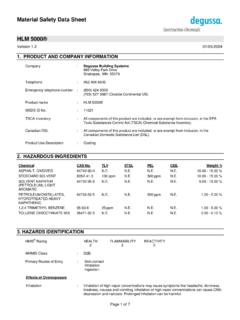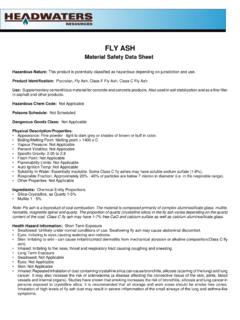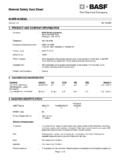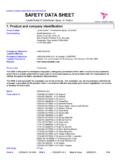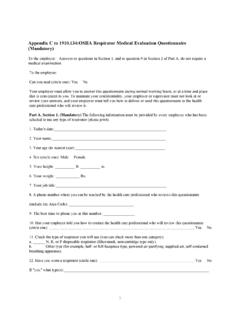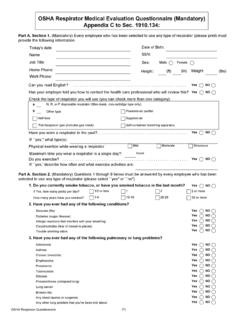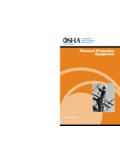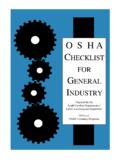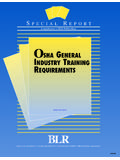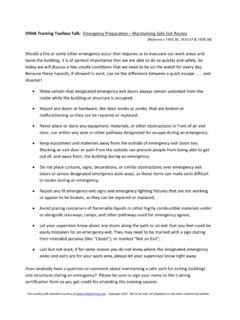Transcription of Material Safety Data Sheet [OSHA 29 CFR 1910.1200]
1 Material Safety data Sheet [ osha 29 CFR ]. The QUIKRETE Companies Emergency Telephone Number Information Telephone Number One Securities Centre (770) 216-9580 (770) 216-9580. 3490 Piedmont Road, Suite 1300. Atlanta, GA 30329. Revision: July 2003 MSDS J. SECTION I: PRODUCT IDENTIFICATION. Product Types: QUIKRETE DRY PACKAGED PORTLAND CEMENT BASED PRODUCTS (SERIES 1). QUIKRETE Product Name Code # QUIKRETE Product Name Code #. CONCRETE MIX 1101 FENCE POST MIX 1005. FIBER REINFORCED CONCRETE 1006 CRACK RESISTANT CONCRETE 1006-80. QUIKRETE 5000 1007 LIGHT WEIGHT CONCRETE 1008. FAST SETTING CONCRETE 1004 RIP RAP 1129. SAND MIX 1103 VINYL CONCRETE PATCHER 1133, 1132. BASIC CONCRETE MIX 1015-60 HANDI-CRETE CONCRETE 1141. LIGHT WEIGHT SAND MIX 1103-51 HANDI-CRETE SAND MIX 1143. HIGH YIELD CONCRETE 1100 B-CRETE 1101-81. TM. COMMERCIAL GRADE FASTSET CEMENT 1124-92. TM. COMMERCIAL GRADE FASTSET NON SHRINK GROUT 1585-09. TM. COMMERCIAL GRADE FASTSET REPAIR MORTAR 1241-60.
2 TM. COMMERCIAL GRADE FASTSET CONCRETE 1004-51. COARSE & FINE CORE FILL GROUTS (MASONRY GROUTS) SR-9003, SR-9006. (ALSO APPLIES TO CUSTOM BLENDED AND PRIVATE LABEL CONCRETES AND MORTARS). SECTION II - HAZARDOUS INGREDIENTS/IDENTITY INFORMATION. Hazardous Components CAS No. PEL ( osha ) TLV (ACGIH). mg/M3 mg/M3. Silica Sand, crystalline 14808-60-7 10 (respirable). % SiO2 +2. Portland Cement 65997-15-1 5 5. Lime 01305-62-0 5 5. May contain one or more of the following: Amorphous Silica 80 mg/M3 10. (From Fly Ash ) 07631-86-9 % SiO2. Alumina (From Fly Ash) 01344-28-1 5 5. Limestone Dust 01317-65-3 5 5. Calcium Sulfate 10101-41-4 or 5 5. 13397-24-5. Calcium Sulfo Aluminate 65997-16-2 15 10. QUIKRETE Material Safety data Sheet page # 2. QUIKRETE DRY PACKAGED PORTLAND CEMENT BASED PRODUCTS (SERIES 1) MSDS J. Other Limits: NIOSH has recommended that the permissible exposure limit be changed to 50 micrograms respirable free silica per cubic meter of air (50 ug/M3) averaged over a work shift of up to 10 hours per day, 40 hours per week.
3 The NIOSH Criteria Document for Crystalline Silica should be consulted for more detailed information. SECTION III - PHYSICAL/CHEMICAL CHARACTERISTICS. Appearance: Gray to gray-brown colored powder. Some products contain coarse aggregate. (QUIKRETE Vinyl Concrete Patcher available in white). Specific Gravity: to Melting Point: >2700 oF Boiling Point: >2700 oF. Vapor Pressure: None Vapor Density: None Evaporation Rate: None Solubility in Water: Slight Odor: None Solubility in Water: Slight SECTION IV - FIRE AND EXPLOSION HAZARD data . Non combustible and not explosive. SECTION V - REACTIVITY data . Stability: Stable. Incompatibility (Materials to Avoid): Contact of silica with powerful oxidizing agents such as fluorine, chlorine trifluoride, manganese trioxide, oxygen difluoride, may cause fires. Hazardous Decomposition or Byproducts: Silica will dissolve in Hydrofluoric Acid and produce a corrosive gas - silicon tetrafluoride. Hazardous Polymerization: Will not occur.
4 Condition to Avoid: Keep dry until used to preserve product utility. SECTION VI - HEALTH HAZARD data . Route(s) of Entry: Inhalation? Yes Skin? Yes Ingestion? Yes Acute Exposure: Product becomes alkaline when exposed to moisture. Exposure can dry the skin, cause alkali burns and effect the mucous membranes. Dust can irritate the eyes and upper respiratory system. Toxic effects noted in animals include, for acute exposures, alveolar damage with pulmonary edema. Chronic Exposure: Dust can cause inflammation of the lining tissue of the interior of the nose and inflammation of the cornea. Hypersensitive individuals may develop an allergic dermatitis. Respirable crystalline silica (quartz) can cause silicosis, a fibrosis (scarring) of the lungs and possibly cancer. There is evidence that exposure to respirable silica or the disease silicosis is associated with an increased incidence of Scleroderma, tuberculosis and kidney disorders. Carcinogenicity Listings: NTP: Known carcinogen osha : Not listed as a carcinogen IARC Monographs: Group 1 Carcinogen California Proposition 65: Known carcinogen NTP: The National Toxicology Program, in its Ninth Report on Carcinogens (released May 15, 2000) concluded that Respirable crystalline silica (RCS), primarily quartz dusts occurring in industrial and occupational settings, is known to be a human carcinogen, based on sufficient evidence of carcinogenicity from studies in humans indicating a causal relationship between exposure to RCS and increased lung cancer rates in workers exposed to crystalline silica dust (reviewed in IAC, 1997; Brown et al.)
5 , 1997; Hind et al., 1997). QUIKRETE Material Safety data Sheet page # 3. QUIKRETE DRY PACKAGED PORTLAND CEMENT BASED PRODUCTS (SERIES 1) MSDS J. IARC: The International Agency for Research on Cancer ( IARC ) concluded that there was sufficient evidence in humans for the carcinogenicity of crystalline silica in the forms of quartz or cristobalite from occupational sources , and that there is sufficient evidence in experimental animals for the carcinogenicity of quartz or cristobalite. The overall IARC evaluation was that crystalline silica inhaled in the form of quartz or cristobalite from occupational sources is carcinogenic to humans (Group 1). The IARC evaluation noted that carcinogenicity was not detected in all industrial circumstances or studies. Carcinogenicity may be dependent on inherent characteristics of the crystalline silica or on external factors affecting its biological activity or distribution of its polymorphs. For further information on the IARC.
6 Evaluation, see IARC Monographs on the Evaluation of carcinogenic Risks to Humans, Volume 68, Silica, Some (1997). Signs and Symptoms of Exposure: Symptoms of excessive exposure to the dust include shortness of breath and reduced pulmonary function. Excessive exposure to skin and eyes especially when mixed with water can cause caustic burns as severe as third degree. Medical Conditions Generally Aggravated by Exposure: Individuals with sensitive skin and with pulmonary and/or respiratory disease, including, but not limited to, asthma and bronchitis, or subject to eye irritation, should be precluded from exposure. Emergency First Aid Procedures: Eyes: Immediately flush eye thoroughly with water. Continue flushing eye for at least 15 minutes, including under lids, to remove all particles. Call physician immediately. Skin: Wash skin with cool water and pH-neutral soap or a mild detergent. Seek medical treatment if irritation or inflammation develops or persists.
7 Seek immediate medical treatment in the event of burns. Inhalation: Remove person to fresh air. If breathing is difficult, administer oxygen. If not breathing, give artificial respiration. Seek medical help if coughing and other symptoms do not subside. Inhalation of large amounts of portland cement require immediate medical attention. Ingestion: Do not induce vomiting. If conscious, have the victim drink plenty of water and call a physician immediately. SECTION VII - PRECAUTIONS FOR SAFE HANDLING AND USE. Spills: If spilled, use dustless methods (vacuum) and place into covered container for disposal or use if not contaminated or wet. Use adequate ventilation. Waste Disposal Method: The packaging and Material may be land filled; however, Material should be covered to minimize generation of airborne dust. This product is not classified as a hazardous waste under RCRA or CERCLA. SECTION VIII - CONTROL MEASURES. Inhalation: DO NOT BREATHE DUST. In dusty environments, the use of an osha , MSHA or NIOSH approved respirator is recommended.
8 Local exhaust can be used, if necessary, to control airborne dust levels. Eyes: Wear tight fitting goggles. Skin: The use of barrier creams or impervious gloves, boots and clothing to protect the skin from contact is recommended. Following work, workers should shower with soap and water. Precautions must be observed because burns occur with little warning -- little heat is sensed. WARN EMPLOYEES AND/OR CUSTOMERS OF THE HAZARDS AND REQUIRED osha PRECAUTIONS. ASSOCIATED WITH THE USE OF THIS PRODUCT. NOTE: The information and recommendations contained herein are based upon data believed to be correct. However, no guarantee or warranty of any kind, express or implied, is made with respect to the information contained herein. We accept no responsibility and disclaim all liability for any harmful effects, which may be caused by exposure to silica contained in our products.
